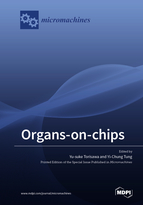Organs-on-chips
A special issue of Micromachines (ISSN 2072-666X). This special issue belongs to the section "B:Biology and Biomedicine".
Deadline for manuscript submissions: closed (31 July 2019) | Viewed by 91618
Special Issue Editors
2. Department of Micro Engineering, Kyoto University, Kyoto 615-8540, Japan
Interests: microfluidics; tissue engineering; biomimetics; mechanobiology; stem cells and niches
Special Issues, Collections and Topics in MDPI journals
Interests: integrated biomedical microdevices; cell culture in various micro-environments; micro/nanofluidics; advanced micro/nano fabrication techniques
Special Issues, Collections and Topics in MDPI journals
Special Issue Information
Dear Colleagues,
Recent advances in microsystems technology and cell culture techniques have led to the development of organ-on-chip microdevices that produce tissue-level functionality, not possible with conventional culture models, by recapitulating natural tissue architecture and microenvironmental cues within microfluidic devices. Since the physiological microenvironments in living systems are mostly microfluidic in nature, the use of microfluidic devices facilitates engineering cellular microenvironments; the microfluidic devices allow for control of local chemical gradients and dynamic mechanical forces, which play important roles in cellular viability and function. The organ-on-chip microdevices have great potential to promote drug discovery and development, to model human physiology and disease, and to replace animal models for efficacy and toxicity testing. Recently, induced pluripotent stem (iPS) cells have been leveraged to develop organs-on-chips, which enable various types of organ models and disease models not possible with primary cells and cell lines. This Special Issue seeks to showcase research papers, short communications, and review articles that focus on: (1) microdevices to mimic or control cellular microenvironment; (2) microdevices to evaluate interactions between different organ models; (3) microdevices to maintain iPS cells or iPSC-derived cells; and (4) sensors and techniques to evaluate drug efficacy or toxicity.
Dr. Yu-suke Torisawa
Dr. Yi-Chung Tung
Guest Editors
Manuscript Submission Information
Manuscripts should be submitted online at www.mdpi.com by registering and logging in to this website. Once you are registered, click here to go to the submission form. Manuscripts can be submitted until the deadline. All submissions that pass pre-check are peer-reviewed. Accepted papers will be published continuously in the journal (as soon as accepted) and will be listed together on the special issue website. Research articles, review articles as well as short communications are invited. For planned papers, a title and short abstract (about 100 words) can be sent to the Editorial Office for announcement on this website.
Submitted manuscripts should not have been published previously, nor be under consideration for publication elsewhere (except conference proceedings papers). All manuscripts are thoroughly refereed through a single-blind peer-review process. A guide for authors and other relevant information for submission of manuscripts is available on the Instructions for Authors page. Micromachines is an international peer-reviewed open access monthly journal published by MDPI.
Please visit the Instructions for Authors page before submitting a manuscript. The Article Processing Charge (APC) for publication in this open access journal is 2600 CHF (Swiss Francs). Submitted papers should be well formatted and use good English. Authors may use MDPI's English editing service prior to publication or during author revisions.
Keywords
- Microfluidics
- Lab on a Chip
- Tissue Engineering
- Cell Culture Methods
- BioMEMS
Related Special Issue
- Organs-on-chips, Volume II in Micromachines (3 articles)







